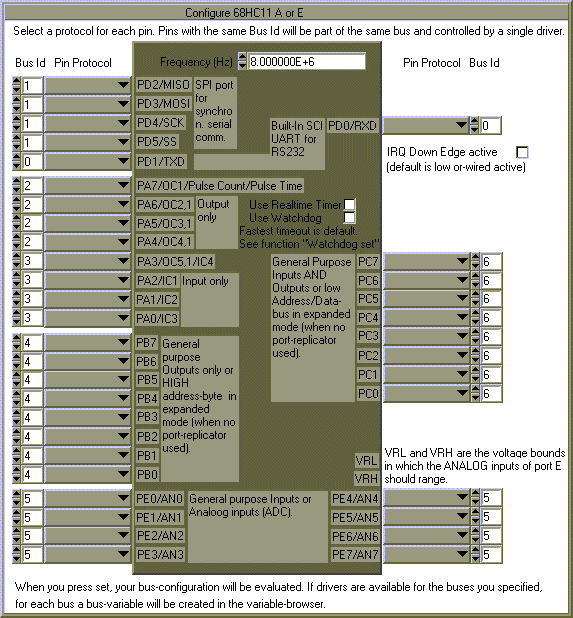Hardware configuration editor: specify how you want to use the pins of your HC11-device
(customizable to match the board of your choice)
Low level IO library (discretes and PULSE output for Servo-control)
Serial RS232 library (both SCI-port and busy bitbanged receive routines)
SPI-bus support library
Master I2C library (bitbanged)
1-wire (Dallas Microlan) library
LCD-control library (6 pin interface)
High level Timer library (i.e. timeout or cycles easy to specify)
ADC-library
High level structured types
No-hassle/easy interrupt-use
Functional simulator showing HC11-I/O
Easy to add built-in libraries yourself!
Low level access to HC11-registers
Compiler generating fast assembly
and tailored REALTIME executive for HC11 to drive STDs
with a small memory-footprint and fully documented/commented!
This target includes configurations, which add point & click programming capability to your
MicroStamp11, Adapt11 and MicroCore11 boards from Technological Arts!
|
|
The Amazing MicroStamp11 of Technological Arts
Powerfull, Easy and Affordable!
|
The Adapt11 from Technological Arts
Fully equiped Modular Prototyping System!
|
|
The HC11 has been around for a while. It is located on the higher-end of the 8bit Microcontroller market. It is comes in many different versions. Every version is highly configurable and easy to program. It is one of the most versatile general purpose 8bit microcontrollers around! Off the shelf boards are offered plenty and support is great, from a high number of vendors. GenerExe engineers have helped to put these little wizards to work in many harsh environments, ranging from sounding rockets to helicopters!
 What can the HC11 do I cannot do with a lower-end microcontroller?
The HC11 is a grownup standalone computer! An 8bit version of what you have on your desktop, in a smaller package, but it can theoretically do the same:
In this light, the HC11 can often be found in the role of a main/general (sub)system controller in charge of several more complex tasks at the same time, as opposed to many of the lower-end microcontrollers, which serve more as "close-to-the-action" single task pre-processors or as digital replacements of analog circuitry. The interrupt- and timer functionality of the HC11 allow for serious multitasking applications, while being close enough to the action to provide sufficient realtime response!
|
|
After assiging protocols to the pins, the involved driver-libraries and driver-handles to access the pins are automatically available in XPad's editors. When you change the clock-speed here, the compiler will automatically re-calculate the right delays to comply to the specification of any supported protocols.
 |
|